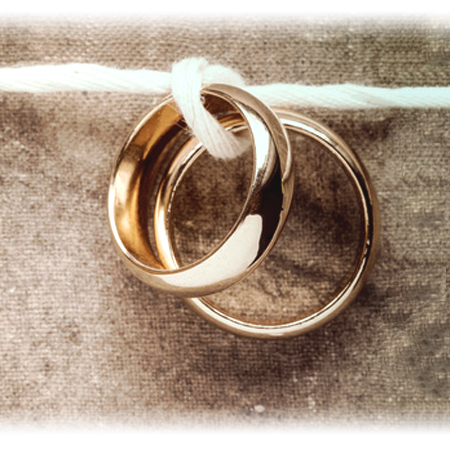With This Ring, I Thee Wed: The His-and-Her story of Wedding Rings

Once married, most of us don’t give a second thought to our wedding ring traditions. We ladies get engaged, we wear a ring; we are joined in matrimony, we wear two rings. But...our husbands just get on the one ring…and it’s not until we’re mid-vows. What’s the story with that? The romantic in me loves a good love story, and so I set out to find out about this one. How did our contemporary American ideas about wedding and engagement rings come about?
Way back in the day, in ancient Egypt (before even Cleopatra), hemp and reeds were used to make rings that a married couple would don. To the ancient Egyptians, circles represented eternity, and therefore the never-ending love between a husband and wife. As you might imagine, hemp and reeds aren't the most durable of materials, and over time, they will fall into disrepair. To remedy this problem, rings began to be fashioned out of ivory, leather, or bone. Eventually, metals made their way onto the scene. The more expensive the material used to craft the ring, the more wealthy the giver was understood to be.
The rings were worn on the third finger of the left hand (don’t forget: the thumb isn’t technically a finger, but if you want to count it, then I suppose you’d say the fourth finger of the left hand). The Egyptians wore the rings on this finger because they believed a vein connected to the heart went through this finger. This vein was later coined the Vena Amoris (the Love Vein in Latin). The Egyptians were not the last to believe this is true, which is probably why we still hold true to this tradition.
So who do you suppose was wearing these fetching hemp rings? Not Pharaoh, I can tell you that. In ancient Egypt, the husband gave his wife a wedding ring, which symbolized his confidence in her abilities to maintain and manage his household.
The ancient Egyptians were not the only ones giving their wives rings. This was the standard practice for most of world history. The Romans took a more logistical and austere approach to wedding rings. Upon betrothal, the future groom presented the father of the bride-to-be with an expensive gold ring, essentially purchasing her. Over time, the bride herself was presented with a gold ring, but this was her “going out” finery. This luxury would have only been worn out in public. At home, where she spent her days managing the household, the Roman wife would have worn a plain iron band, although it may have had a lock-and-key design.
Puzzle rings were used often in the Middle East and Asia. These rings featured three interlocking rings which were very difficult to put back together and get to lay flat if they were taken off. Essentially, the idea was that if your lady took her wedding ring off, you would be able to easily tell so. In 16th and 17th century Europe, the puzzle ring evolved a little and got just a little more romance thrown into the mix. In those days, a couple shared a two-piece puzzle ring, called a gimmel ring, throughout their engagement and once the marriage was official, the wife wore both pieces locked together.
Things continued on this way for centuries, pretty much unchanged. But then in the 1920s, some marketing geniuses, and I use that term loosely, thought that girls shouldn’t have all the fun. Out of this “me too!” attitude, the male engagement ring burst onto the advertising scene. Unfortunately, because this marketing push required an almost secret appeal to women, it flopped.
After this dismal failure, it was another two decades until the American man got his moment to shine with wedding jewelry. During the World War II era, with women joining the workforce in scores to promote the war effort, double-ring ceremonies became more and more common. Women were able to give their husbands a wedding ring unlike ever before. The double-ring ceremony started to be viewed as a more egalitarian tradition, with each spouse vowing to the other to love and cherish them for eternity. The rings symbolized this idea of a romantic forever after, similar to how rings have represented eternity for many cultures over the course of human history.
The common understanding of the double-ring ceremony that we think of as traditional in this country (where the girl gets an engagement ring, then a wedding band; and the husband gets a wedding band), is really only the standard here in the US. In many European countries, both people wear an engagement ring, and while the woman may be given another jeweled ring to accompany it, the engagement rings (for both parties) take on a new meaning once the couple is married.
There may be a tendency to read into the social undertones of historical accounts of wedding jewelry, but that isn’t the case anymore. The wedding ring is nothing but a symbol. It only represents what you give it the power to represent. Your wedding ring is an integral part of you and your spouse’s love story. It speaks volumes about who you are, and what your relationship is about. No matter the history of the wedding ring, your wedding ring’s future is all about you and your beloved.
Yours with Love,
Rebecca
Share This Page:












